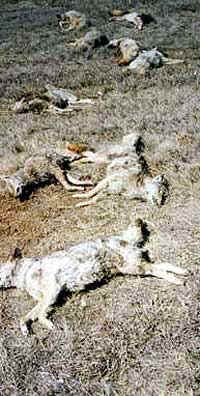"The hunting and killing of animals has become a form of
recreation; it is rarely necessary for human survival. Less than seven percent
of the U.S. population hunts. Hunting is permitted on 60 percent of U.S.
wildlife refuges and in many national forests and state parks. Forty-five
percent of hunters do their killing on public lands. On federal land alone
(more than half a billion acres), more than 200 million animals are killed
every year."
"It is illogical that hunters are allowed to kill and maim animals who
theoretically "belong" equally to the 93 percent of Americans who
don't hunt. But because the state wildlife commissions and federal agencies
that regulate hunting are now run by hunters, they perpetuate hunting year
after year, regardless of the ecological damage it causes or the objections of
nonhunters.
"Powerful hunting lobbies in 35 states have persuaded lawmakers to enact
"hunter harassment" laws that make it illegal for nonhunters to
interfere in behalf of animals targeted by hunters, but these laws are being
challenged on constitutional grounds. Connecticut's law was found to impact on
freedom of speech without a compelling state interest and was struck down by a
U.S. appeals court.
"Conserving" What?
"Wildlife management" and "conservation" are euphemisms
used to describe programs that ensure that there are always enough animals for
hunters to hunt.
"Every year tax dollars are spent to burn, bulldoze, and otherwise
manipulate the environment to support the feeding and breeding of
"game" animals, at the expense of the variety of species who share
that habitat.
 |
Hunting programs also cause wildlife overpopulation
by:
• stimulating breeding by conducting
"buck only" hunts, which can leave as many as six does per
buck;
• pen-raising quail, grouse, and pheasants for use as
hunters' targets;
• transporting raccoons, antelopes, martens, wild turkeys,
and other animals from one state to another to bolster populations for
hunters; and
• exterminating predators like wolves and mountain lions in
order to throw prey populations off balance, thereby
"justifying" the killing of both "dangerous" and
"surplus" animals. |
"Natural Balance
"The ecosystem and food chain form a complex web of interdependencies that,
if left alone, provide for the survival of most species. Natural predators
help themselves and their prey species to survive by killing only the sickest
and weakest animals. Hunters, however, kill any animal that they come across
or any animal that would look best mounted above the fireplace--often the
large, healthy animals needed to keep the population strong.
"In fact, hunting creates ideal conditions for accelerated reproduction. The
abrupt drop in population leads to less competition among survivors, resulting
in a higher birth rate. Even if an unusual disaster caused an animal
population to temporarily overpopulate, the group would soon stabilize through
natural processes. Starvation and disease are unfortunate, but they are
nature's way of ensuring that the strong survive. Shooting an animal because
he or she might starve or might get sick is arbitrary and destructive; the
healthiest animals find a way to survive and maintain the strength of the
entire herd or group.
"The stress that hunting inflicts on animals--the noise, the fear, and the
constant chase--severely restricts their ability to eat adequately and store
the fat and energy they need to survive the winter. Hunting also disrupts
migration and hibernation, and the campfires, recreational vehicles, trash,
and other hunting side effects endanger both wildlife and the environment. For
animals like wolves who mate for life and have close-knit family units,
hunting can severely harm entire communities. Rampant poaching for
"trophy" animals and commercial gain is squeezing vulnerable
populations.
"The Real Cost
"Hunters claim that they pay for "conservation" by buying hunting
licenses, duck stamps, etc. But the relatively small amount each hunter pays
does not cover the cost of hunting programs or game warden salaries. The
public lands many hunters use are supported by taxpayers. U.S. Fish and
Wildlife Service programs, which benefit hunters, get most of their funds from
general tax revenues, not hunting fees. Funds benefitting "nongame"
species are scarce.
"Hunters kill more animals than recorded tallies indicate. It is estimated
that, for every animal a hunter kills and recovers, at least two wounded but
unrecovered animals die slowly and painfully of blood loss, infection, or
starvation. Those who don't die often suffer from disabling injuries. Because
of carelessness, scores of horses, cows, dogs, cats, hikers, and others are
wounded or killed each year by hunters. In 1988, 177 people were killed and
1,719 injured by hunters while walking through the woods or on their own
property.
"Before you support a "wildlife" or "conservation"
group, ask if it supports hunting. Such groups as the National Wildlife
Federation, the National Audubon Society, the Sierra Club, the Izaak Walton
League, the Wilderness Society, World Wildlife Fund, and many others are
pro-hunting."
